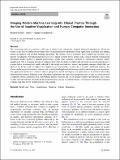Bringing modern machine learning into clinical practice through the use of intuitive visualization and human-computer interaction
Abstract
The increasing trend of systematic collection of medical data (diagnoses, hospital admission emergencies, blood test results, scans, etc) by healthcare providers offers an unprecedented opportunity for the application of modern data mining, pattern recognition, and machine learning algorithms. The ultimate aim is invariably that of improving outcomes, be it directly or indirectly. Notwithstanding the successes of recent research efforts in this realm, a major obstacle of making the developed models usable by medical professionals (rather than computer scientists or statisticians) remains largely unaddressed. Yet, a mounting amount of evidence shows that the ability to understand and easily use novel technologies is a major factor governing how widely adopted by the target users (doctors, nurses, and patients, amongst others) they are likely to be. In this work we address this technical gap. In particular, we describe a portable, web-based interface that allows healthcare professionals to interact with recently developed machine learning and data driven prognostic algorithms. Our application interfaces a statistical disease progression model and displays its predictions in an intuitive and readily understandable manner. Different types of geometric primitives and their visual properties (such as size or colour) are used to represent abstract quantities such as probability density functions, the rate of change of relative probabilities, and a series of other relevant statistics which the heathcare professional can use to explore patients’ risk factors or provide personalized, evidence and data driven incentivization to the patient.
Citation
Osuala , R , Li , J & Arandelovic , O 2019 , ' Bringing modern machine learning into clinical practice through the use of intuitive visualization and human-computer interaction ' , Augmented Human Research , vol. 4 , 3 . https://doi.org/10.1007/s41133-019-0012-7
Publication
Augmented Human Research
Status
Peer reviewed
ISSN
2365-4317Type
Journal article
Rights
Copyright The Author(s) 2019. This article is distributed under the terms of the Creative Commons Attribution 4.0 International License (http://creativecommons.org/licenses/by/4.0/), which permits unrestricted use, distribution, and reproduction in any medium, provided you give appropriate credit to the original author(s) and the source, provide a link to the Creative Commons license, and indicate if changes were made.
Collections
Items in the St Andrews Research Repository are protected by copyright, with all rights reserved, unless otherwise indicated.

